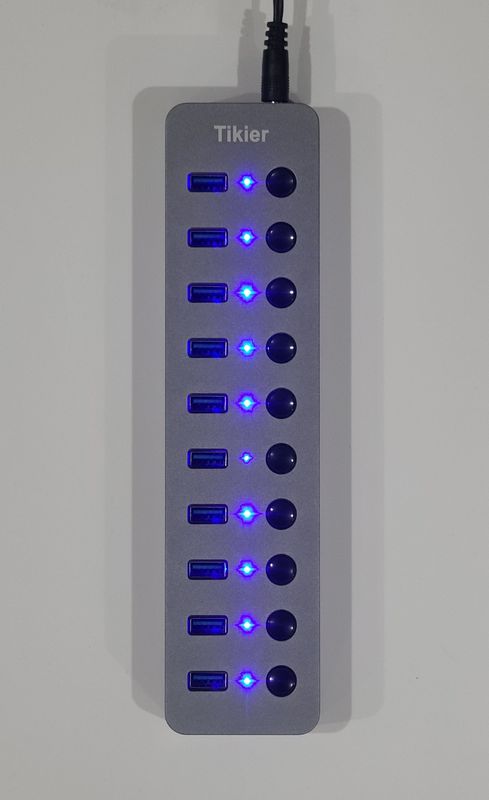 REVIEW
REVIEW – Many laptops include only one USB port. The Tikier 10-port USB 3.0 hub solves the need to perform the USB swap by providing all the ports most people will ever need and up to 12 watts of charging power per port. I have one to review; read on to see what I think!
What is it?
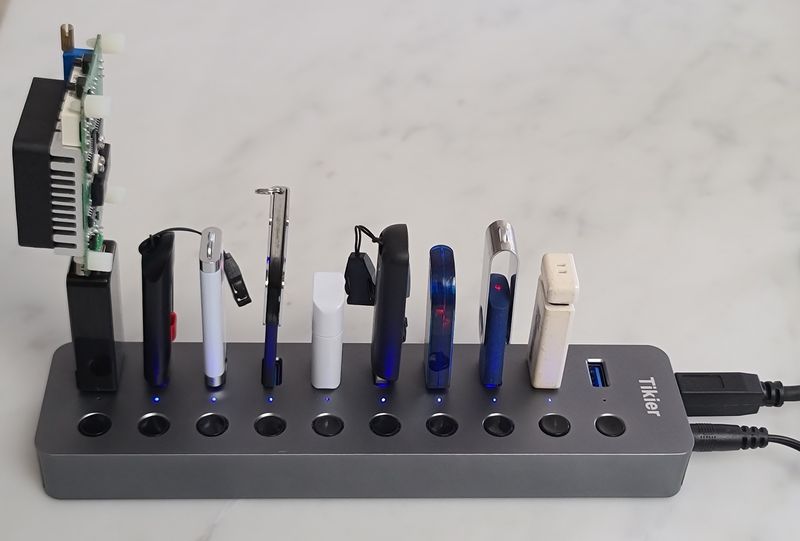
The Tikier 10-port USB 3.0 hub is a USB hub with individual switches to activate or deactivate each port. The hub complies with the USB 3.0 specification to permit transfer speeds of up to 5 GBps and the BC1.2 specification, which defines the mechanisms to permit USB devices to draw current higher than standard USB current. The Tikier 10-port USB 3.0 hub is powered by the attached device and includes a 48-watt DC power adapter to supplement the current supplied by the host computer.
What’s in the box?
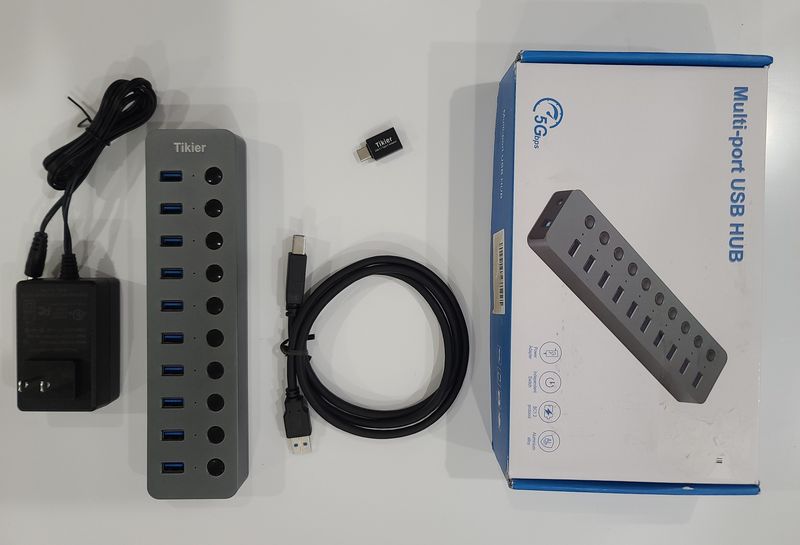
- Tikier 10-port USB 3.0 hub
- 12 V/4 A DC-in Power Adapter ( 3.94 ft)
- USB 3.0 A-Male to B-Male(3.3 ft)
- USB 3.0 A-Female to C-Male adapter
Hardware specs
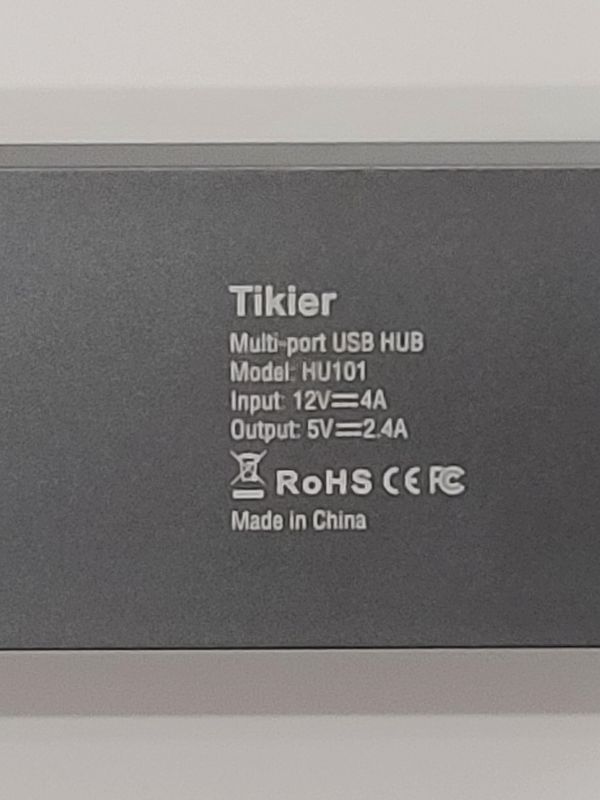
- Model: HU101
- System compatibility: Windows XP /2000/Vista, WIN7/8/10, Mac OS, and Linux Supported
- Product Size 8.97*2.2*0.92 in
- Package size 9.56*5.52*2.16 in
- Input power 100-240 V 50/60 HZ
- Input 12 V/4 A
- Output 5 V/2.4 A
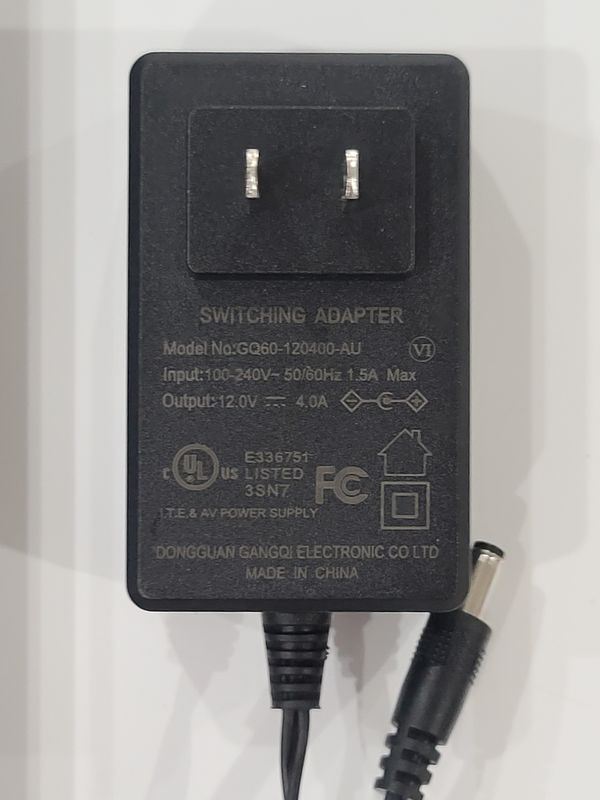
Design and features
Unboxing
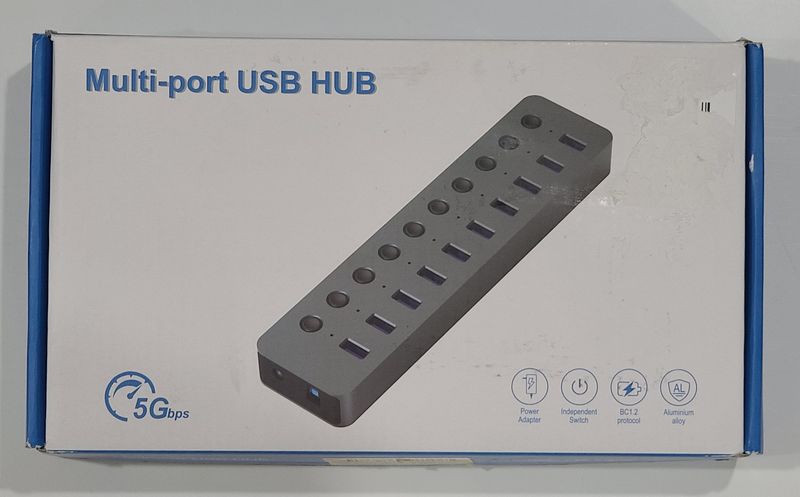
The Tikier 10-port USB 3.0 hub comes in a full-color box with pictures of the hub on the front. The sides of the box are labeled “multi-port USB hub.” There is more information about the product printed on the bottom of the box.
Inside the box, the Tikier 10-port USB 3.0 hub is held in place with cardboard sections.
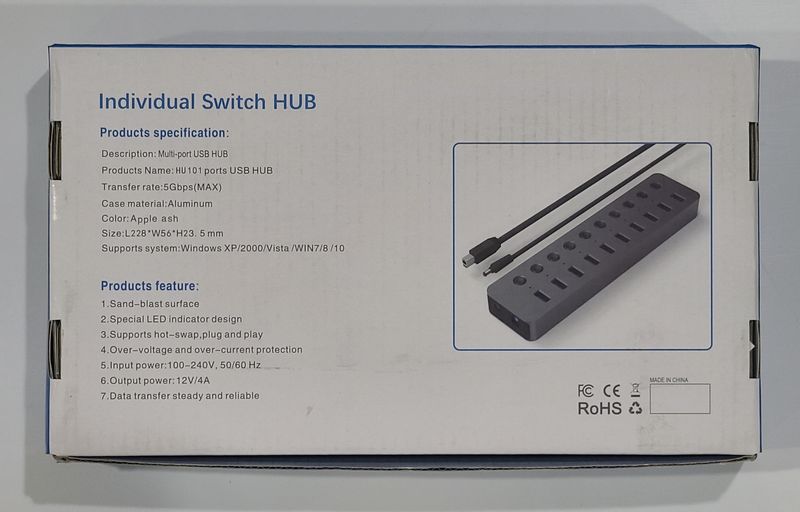
Setup
The Tikier 10-port USB 3.0 hub is truly plug-and-play. When it is installed for the first time a driver is installed for the hub controller and no other setup is required. The hub can power a few peripherals depending on the computer’s current output and the current draw of the peripheral. The AC adapter can be used for powering the entire adapter based on the standard current draw of 900 mA for the USB 3.0 specification or 500 mA for the USB 2.0 specification. A USB 3.0 type A to type C adapter is provided if the Tikier 10-port USB 3.0 hub is attached to a host with only a type C port available.
Design
The Tikier 10-port USB 3.0 hub has a very utilitarian design. The hub is a rectangular solid of aluminum with USB ports and circular black on/off buttons on the top and the DC power and adapter connection on the front. The base has 4 rubber feet. The gun-metal color compliments either a PC or a Mac. The brand is labeled on the top of the hub in white lettering and the product specifications are listed on the bottom in white lettering. The front and back of the hub are black plastic.
The spacing between the ports is large enough to permit larger adapters to be inserted. Equally spaced, there is about a 1/4-inch clearance on each side of each port. There is even more room at either end of the row of ten.
While the solid aluminum provides superb structure and resistance, the build quality has some barely noticeable but present inconsistencies. The buttons sit at slightly different levels inside the case. It seems that every other button is slightly taller than the neighboring one. Pressing the buttons down on the hub has fixed all of the levels except one button. This is not a functional issue and is barely a noticeable cosmetic issue, but because of the minimalistic design of the hub, this may be more noticeable than if there were other design elements that distracted from it.
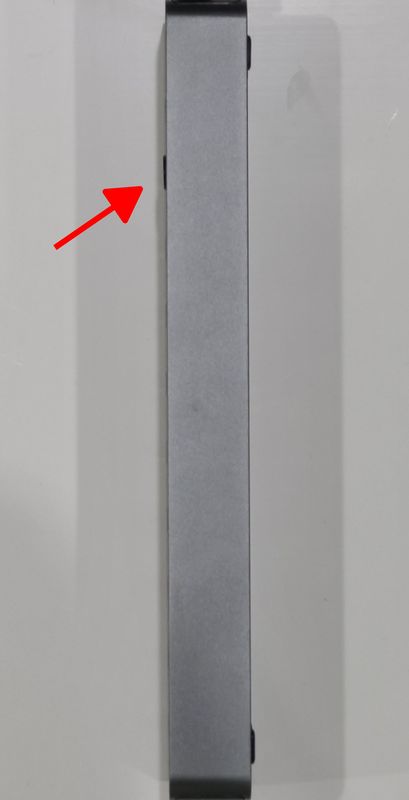
The buttons are momentary tactile touch switches and the state of the USB connection is accomplished through software. Therefore each time the hub is powered up the buttons need to be pressed to activate each installed USB peripheral. It would be interesting if the hub used latching buttons so that the state of each port was maintained each time the hub was used.
Performance
Tikier 10-port USB 3.0 hub has a claimed maximum transfer rate of 5Gbps. That’s a small b for bit, and equates to 625 MB/sec for the entire hub to share. I did some benchmarks using CrystalDiskMark 7.0 and found that the transfer rates were about equal when USB drives were used through the hub and in the ports included in the laptop. Transfers from the ports on the laptop to the hub and from ports on the hub to other ports on the hub occurred at about the same rate as well.
Hard drive on the hub
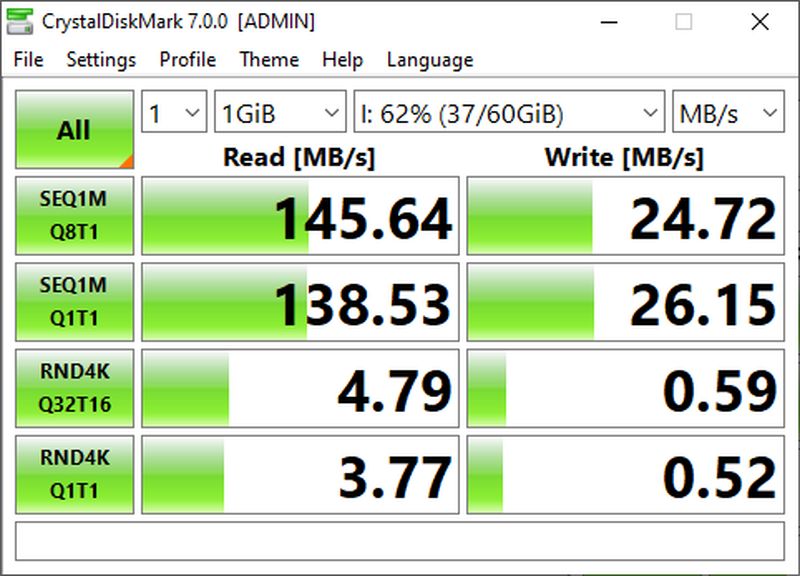
Hard drive on the laptop
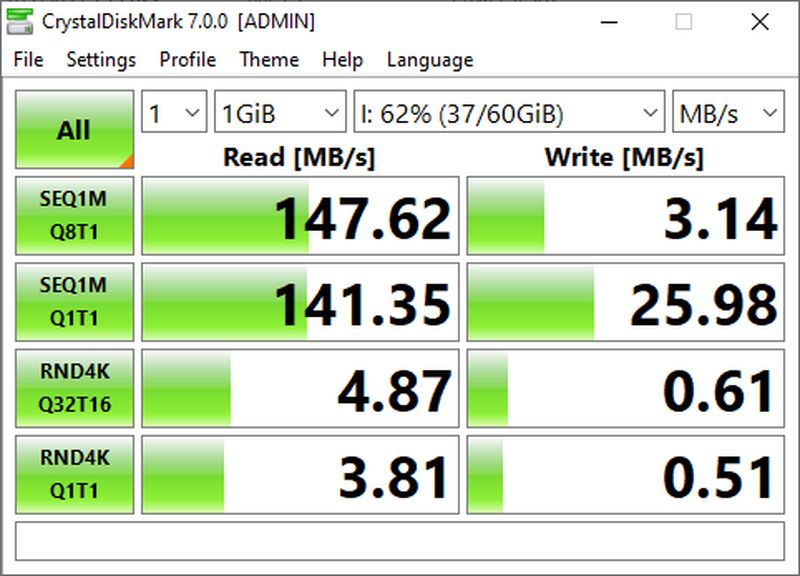
USB stick on the hub
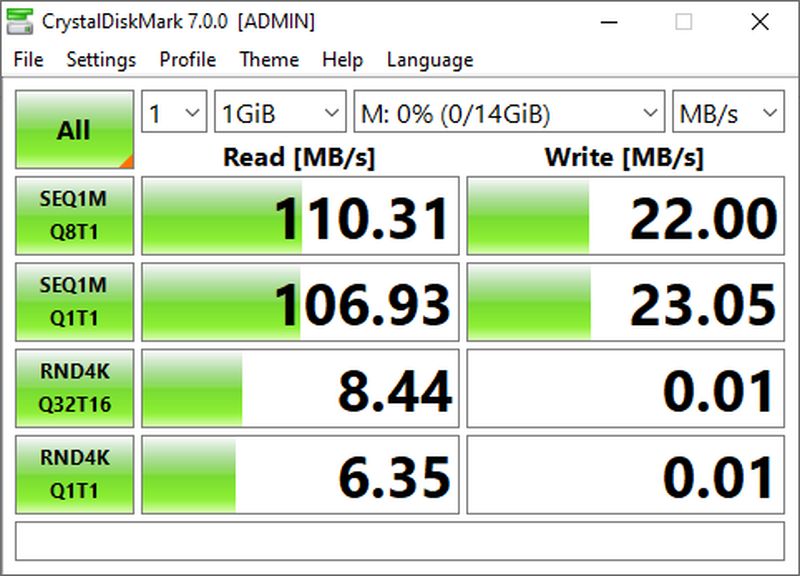
USB stick on the laptop
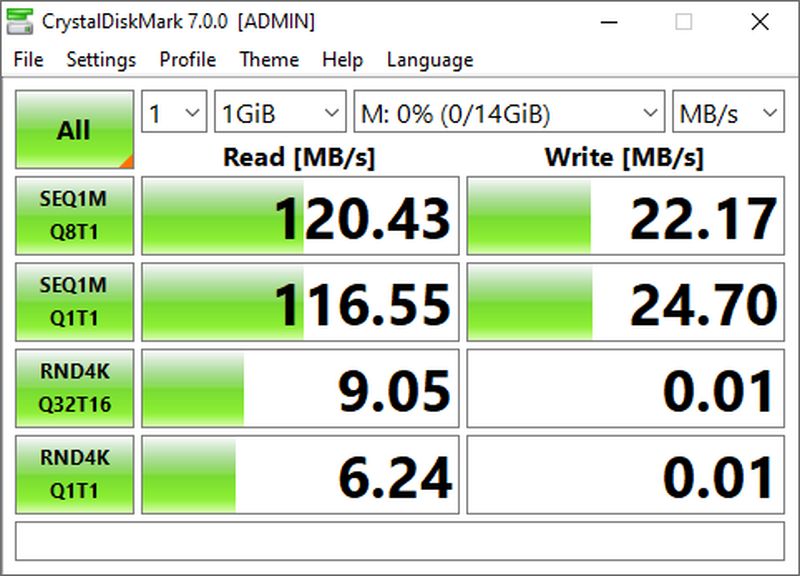
USB stick on the hub
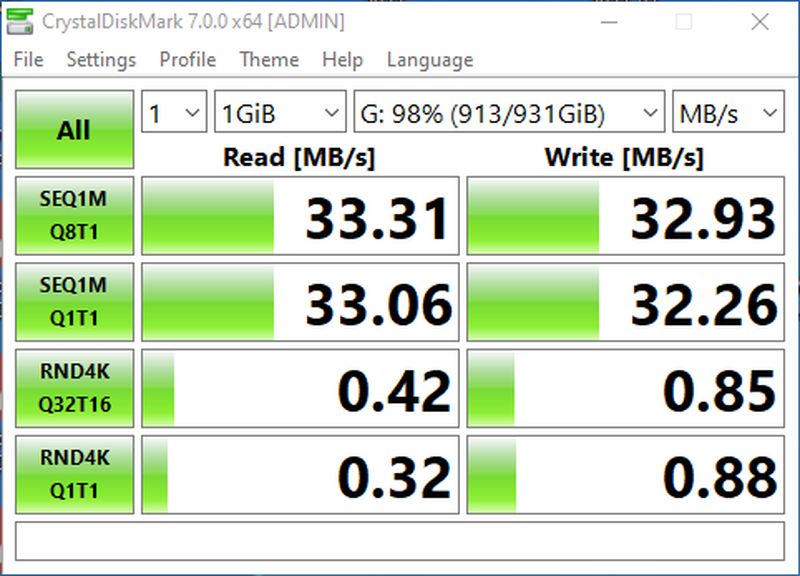
USB stick on the laptop
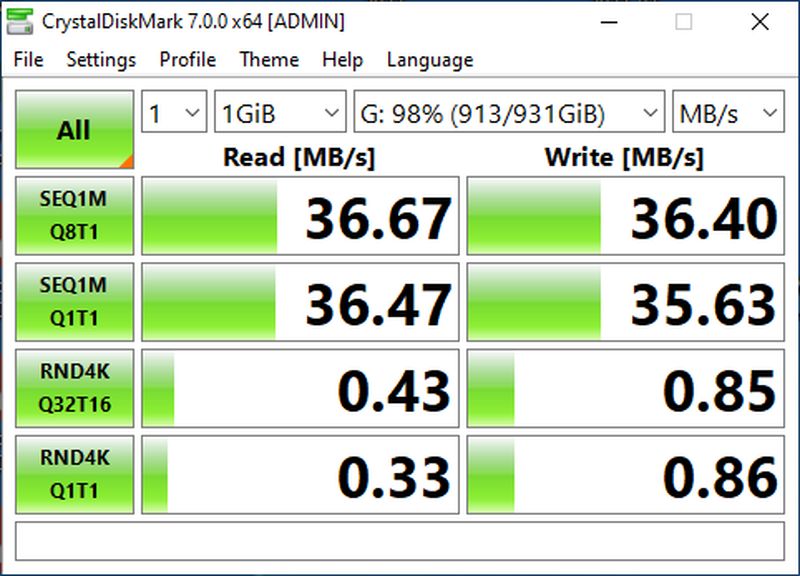
Transfers from hard drives on the hub were also consistent with the rates achievable with the drives installed on the native ports on the computer. There is an insignificant slowdown that occurs because the data on the hub needs to go through two controllers in order to be processed while the data from the native ports only need to go through one.
I also used this hub on my Android S20 Ultra running Android 13 and I was able to read all of the drives. Total Commander is used to display the mounted drives.
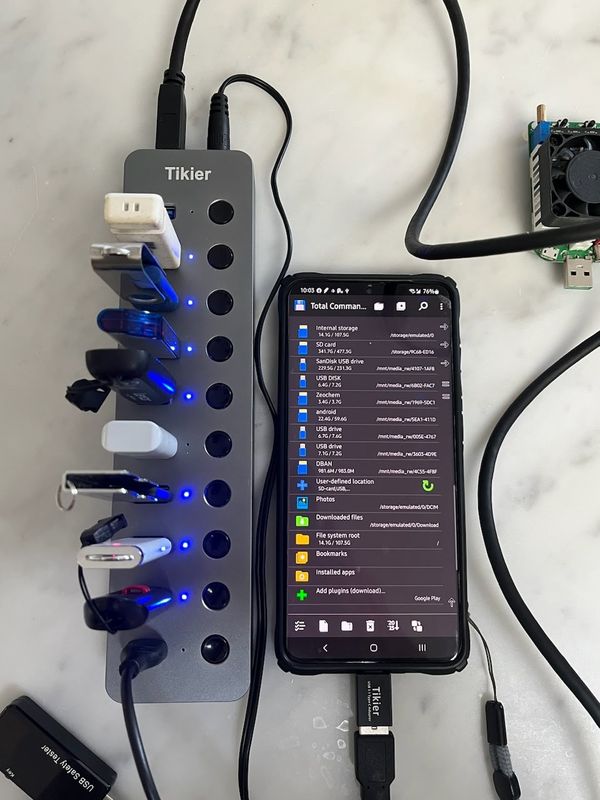
The power supplied to each port is sufficient for data transfer but the Tikier 10-port USB 3.0 hub isn’t designed to charge phones, tablets, computers, or devices quickly. The hub is able to supply 19 W to my USB load and voltage measurement key, and maybe more, but this is the maximum capacity of the testing hardware.
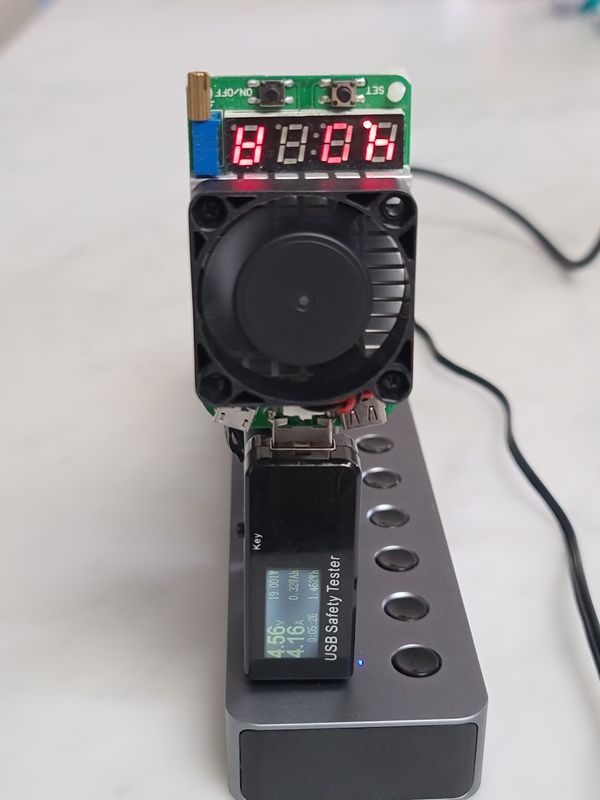
However, for some reason, the hub was unable to charge an iPhone 12.
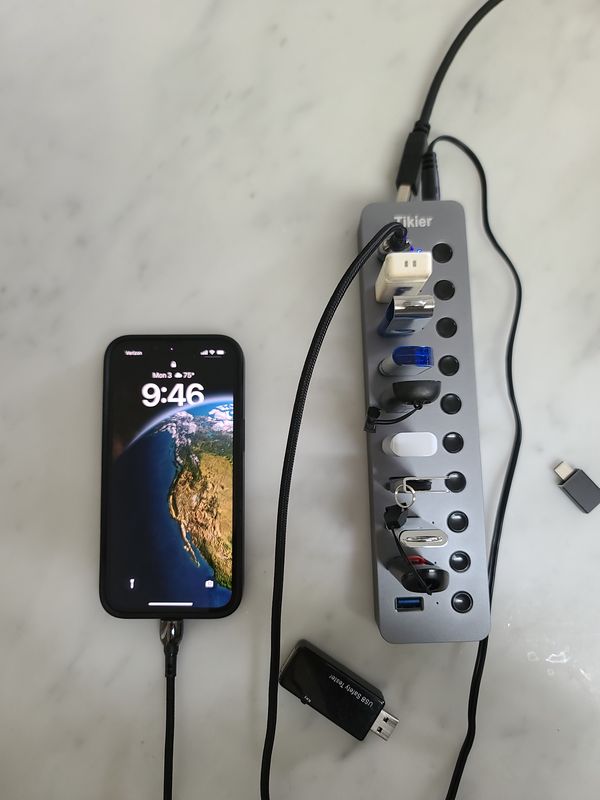
While it can charge the android phone, the hub and mobile are unable to negotiate a higher powered charging rate.
A more robust power supply and a couple of high-power USB-C ports that comply with the Quick Charge standard are changes that would require a major redesign. As it is, the main use of this device is to power devices that are not rechargeable.
What I like
What I’d change
- remember the last used state of the button
Final thoughts
As laptops get smaller, devices communicate by Bluetooth, and storage progressively becomes a cloud service, the need for multiple USB ports is becoming a less desired feature. For people who have collections of data on USB or other removable media, such as CD and DVDs, the need for USB ports and potentially more than one USB port becomes a requirement that the Tikier 10-port USB 3.0 hub fulfills. I have also used this device as a substitute for a KVM switch, of sorts so that only one USB cable needs to be moved between computers to swap the keyboard and mouse dongle as well as any attached storage. The Tikier 10-port USB 3.0 hub definitely makes managing my USB drive collection more manageable. If you’re a USB drive collector too then pick up a Tikier 10-port USB 3.0 hub to simplify using more than one drive with a push of a button.
Price: $45.99
Where to buy: Amazon
Source: The sample of this product was provided by Tikier.
 REVIEW – Many laptops include only one USB port. The Tikier 10-port USB 3.0 hub solves the need to perform the USB swap by providing all the ports most people will ever need and up to 12 watts of charging power per port. I have one to review; read on to see what I think!
REVIEW – Many laptops include only one USB port. The Tikier 10-port USB 3.0 hub solves the need to perform the USB swap by providing all the ports most people will ever need and up to 12 watts of charging power per port. I have one to review; read on to see what I think!
 The Tikier 10-port USB 3.0 hub is a USB hub with individual switches to activate or deactivate each port. The hub complies with the USB 3.0 specification to permit transfer speeds of up to 5 GBps and the BC1.2 specification, which defines the mechanisms to permit USB devices to draw current higher than standard USB current. The Tikier 10-port USB 3.0 hub is powered by the attached device and includes a 48-watt DC power adapter to supplement the current supplied by the host computer.
The Tikier 10-port USB 3.0 hub is a USB hub with individual switches to activate or deactivate each port. The hub complies with the USB 3.0 specification to permit transfer speeds of up to 5 GBps and the BC1.2 specification, which defines the mechanisms to permit USB devices to draw current higher than standard USB current. The Tikier 10-port USB 3.0 hub is powered by the attached device and includes a 48-watt DC power adapter to supplement the current supplied by the host computer.



 The Tikier 10-port USB 3.0 hub comes in a full-color box with pictures of the hub on the front. The sides of the box are labeled “multi-port USB hub.” There is more information about the product printed on the bottom of the box.
Inside the box, the Tikier 10-port USB 3.0 hub is held in place with cardboard sections.
The Tikier 10-port USB 3.0 hub comes in a full-color box with pictures of the hub on the front. The sides of the box are labeled “multi-port USB hub.” There is more information about the product printed on the bottom of the box.
Inside the box, the Tikier 10-port USB 3.0 hub is held in place with cardboard sections.

 The buttons are momentary tactile touch switches and the state of the USB connection is accomplished through software. Therefore each time the hub is powered up the buttons need to be pressed to activate each installed USB peripheral. It would be interesting if the hub used latching buttons so that the state of each port was maintained each time the hub was used.
The buttons are momentary tactile touch switches and the state of the USB connection is accomplished through software. Therefore each time the hub is powered up the buttons need to be pressed to activate each installed USB peripheral. It would be interesting if the hub used latching buttons so that the state of each port was maintained each time the hub was used.
 Hard drive on the laptop
Hard drive on the laptop
 USB stick on the hub
USB stick on the hub
 USB stick on the laptop
USB stick on the laptop
 USB stick on the hub
USB stick on the hub
 USB stick on the laptop
USB stick on the laptop
 Transfers from hard drives on the hub were also consistent with the rates achievable with the drives installed on the native ports on the computer. There is an insignificant slowdown that occurs because the data on the hub needs to go through two controllers in order to be processed while the data from the native ports only need to go through one.
I also used this hub on my Android S20 Ultra running Android 13 and I was able to read all of the drives. Total Commander is used to display the mounted drives.
Transfers from hard drives on the hub were also consistent with the rates achievable with the drives installed on the native ports on the computer. There is an insignificant slowdown that occurs because the data on the hub needs to go through two controllers in order to be processed while the data from the native ports only need to go through one.
I also used this hub on my Android S20 Ultra running Android 13 and I was able to read all of the drives. Total Commander is used to display the mounted drives.
 The power supplied to each port is sufficient for data transfer but the Tikier 10-port USB 3.0 hub isn’t designed to charge phones, tablets, computers, or devices quickly. The hub is able to supply 19 W to my USB load and voltage measurement key, and maybe more, but this is the maximum capacity of the testing hardware.
The power supplied to each port is sufficient for data transfer but the Tikier 10-port USB 3.0 hub isn’t designed to charge phones, tablets, computers, or devices quickly. The hub is able to supply 19 W to my USB load and voltage measurement key, and maybe more, but this is the maximum capacity of the testing hardware.
 However, for some reason, the hub was unable to charge an iPhone 12.
However, for some reason, the hub was unable to charge an iPhone 12.
 While it can charge the android phone, the hub and mobile are unable to negotiate a higher powered charging rate.
A more robust power supply and a couple of high-power USB-C ports that comply with the Quick Charge standard are changes that would require a major redesign. As it is, the main use of this device is to power devices that are not rechargeable.
While it can charge the android phone, the hub and mobile are unable to negotiate a higher powered charging rate.
A more robust power supply and a couple of high-power USB-C ports that comply with the Quick Charge standard are changes that would require a major redesign. As it is, the main use of this device is to power devices that are not rechargeable.



Gadgeteer Comment Policy - Please read before commenting
This review of the Tikier 10-port USB 3.0 hub is incredibly insightful! 🌟 As someone who’s always in need of more USB ports, this article couldn’t have come at a better time. The detailed breakdown of its features and performance really helped me understand how it could fit into my setup. 💻 Plus, the personal anecdotes and real-world usage scenarios shared in the review gave me a clear picture of what to expect. 📸 Overall, this information is super useful for me, and I’m seriously considering adding the Tikier hub to my tech arsenal. Thanks for sharing such a helpful review! 🙌